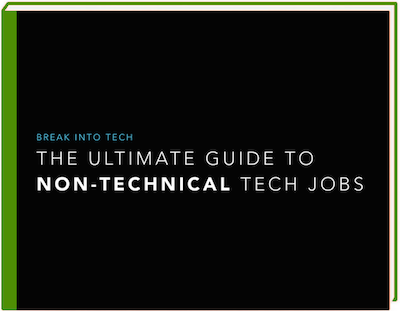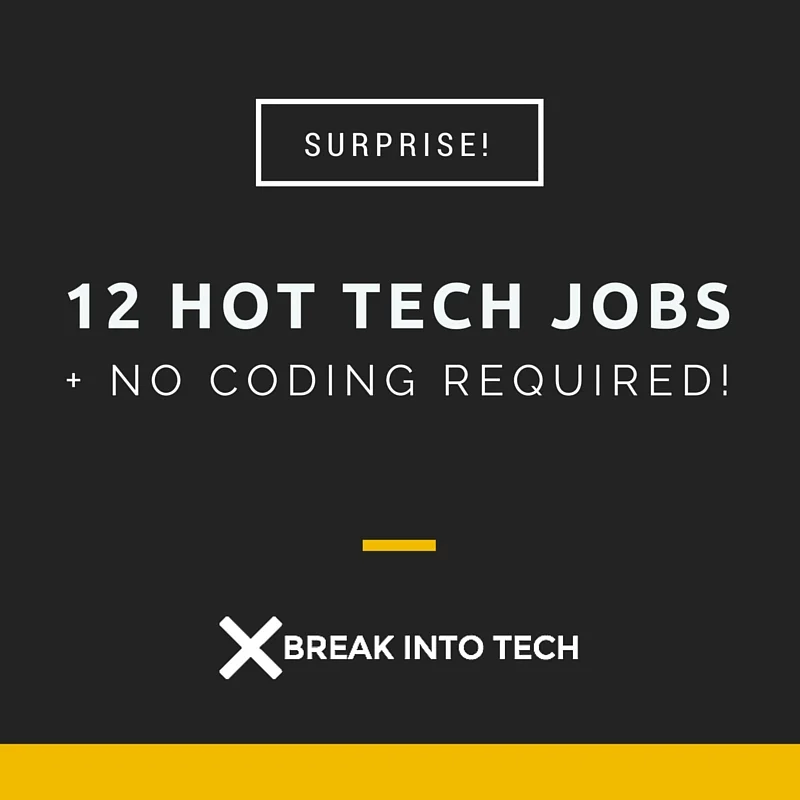What's the best kept secret in tech?
Hint: It's not that Apple is working on a car...
Nope, it's the fact that there are actually 3x more tech jobs for non-coders than for programmers. This secret is so well-guarded that even President Obama recommended that liberal arts majors pick up some technical skills in order to land a good job!
Sorry Mr. President, the cat's out of the bag now. But what are these roles, exactly? And which ones are right for you?
What are the roles?
To understand the different options out there, let's look at how tech companies are structured. Unlike companies in traditional industries where each function is siloed from the others (e.g., the marketers usually only work with other marketers), tech firms are highly matrixed. And no, this doesn't mean that everyone in tech has taken the red pill. It simply means that tech teams organize around products - not functions.
For instance, the LinkedIn mobile app product team comprises a whole suite of functions - product managers, engineers, marketers, designers, data scientists, etc. And while each team member ultimately reports up to their functional leadership, they're going to spend most of their time working directly with their product teammates, regardless of function. This matrixed approach is a perfect fit for this world, given that shipping new products is the lifeblood of any tech company - and that's an inherently interdisciplinary undertaking.
To see why launching new products is, by necessity, a cross-functional venture, let's think about the lifecycle of a tech product, say that fabled new Apple car.
Sure, if Apple has decided to pull the trigger, they'll need lots of engineers to architect it and designers to make it look awesome. But consider this:
Who would hire those engineers and designers?
Who would tell them what to build?
Who would get millions of people to buy it?
Indeed, even the most talented technical folks need help at each stage of a product's development and launch. That's why 12 different non-technical roles come together to make the impossible, possible:
BizOps - Before Apple plunks down billions on a massive new project, it's going to want to make sure it's a worthy venture. So the company has its Business Operations team crunch the numbers. How large is the market? How fast is it growing? And what's the ROI?
HR - Once the project gets the green light, HR is tasked with hiring the right people for the job. Day and night, they scour LinkedIn, looking for the perfect candidates from both schools and the automotive industry.
CorpDev - Even with awesome recruiters, it takes a while to hire enough talent for a huge project like a new car. So the Corporate Development team swings into action, acquiring startups in the space to bring on dozens of new staffers in one fell swoop.
Research - With the team starting to come together, the Research function briefs them on trends in the marketplace. Market Researchers help them understand the demographics and psychographics of car buyers. And User Experience Researchers help them analyze the specific frustrations that this audience has with the existing options on the market.
PM - Inspired by these insights, Product Managers start to scope out the concept for the new product. Working with engineers and designers, they put together specifications for how the product should work and what it should do.
Project - With a vision in place, it's up to the Project Managers to work with the engineers to execute it. Taking the specifications, they break the project into tasks, delegate them to specific staff, and then manage performance on a daily basis to ensure the product launches on-time.
Ops - As the engineers work to bring the car to life, the Operations team works just as hard to make sure it can be built at scale. Either by partnering with existing manufacturers or developing their own factories, Operations pros organize a clear supply chain for every part as well as the assembly capacity to bring those parts together into a finished product.
Marketing - With a huge launch on the horizon, the Marketing team starts ensuring there will be at least as much demand in the marketplace as there is supply. They do this by creating content (e.g., a video featuring Jony Ive pontificating about the car's world-class "aluminium" :) and campaigns (e.g., a well-publicized keynote before the launch, followed by millions of dollars of advertising at launch) that stir the market into a frenzy.
BD - Another key way to stoke demand is to find strategic partners ahead of time. For instance, the Business Development team could forge a partnership with Hertz to ensure that travelers can test drive the car around the world - perhaps compensating for the absence of Apple dealerships.
Sales - When launch day finally arrives, the Sales team helps close the deal for any buyer who needs additional persuasion. For instance, a Sales pro could close a deal to sell 1,000 cars to a taxi fleet by handling the objections of the company's owner.
CS - Because Apple is all about delighting its customers, the product launch doesn't end at the point of sale. Instead, the Customer Success team works with existing clients to ensure their satisfaction, perhaps driving new cars to the customer's door or checking-in a year later with a free tune-up.
Finance - And no product launch would be complete without a summation of the results. Here, the Finance + Accounting teams crunch the data on sales, letting Tim Cook crack a wide smile during his quarterly earnings call.
So while every tech company may not have every one of these roles (including Apple!), hopefully this gives you a sense of just how many different kinds of people are required to pull off a major product launch. As much as singular visionaries get the spotlight in tech, launching something new really is a team effort.
Which role is right for me?
Given all these roles, how do you find the one that suits you best? The trick is to hone in on what roles are really like - not just their titles. Here's why:
When I was first trying to break into the tech sector, I was daunted by the fact that none of my past titles even remotely matched the titles I wanted:
But then I realized that titles are more a function of your industry's traditions than a true reflection of what the jobs are about. In my case, having worked in the education and nonprofit sectors, I was loaded down with a lot of NGO jargon ("Fellow," "Program Associate"). But when I dug a little deeper, I realized that the essence of those roles was actually really similar to the kind of work I wanted:
For example, as a recruiter for Teach For America, I had to understand the students I wanted to recruit, figure out how to reach them, convince them to try teaching, and then measure my success. And then later, as a marketer at LinkedIn, I had to understand my student audience, figure out where to find them online, convince them to try LinkedIn, and measure the ROI of my campaigns.
Not so different, right - even though the titles ("Recruitment Fellow" vs. "Product Marketing Manager") were worlds apart.
So in order to find your own true fit, consider this exercise:
Imagine a spectrum of jobs from highly analytical (e.g., consulting) to highly interpersonal (e.g., sales).
Reflect on the kind of work you've done in the past that's brought you the most satisfaction. A good test is to think about a time when you were so immersed in what you were doing that the hours just flew by. Were you trying to solve an equation, lead a spirited team meeting, or something in-between?
Locate that kind of work on the spectrum below and then find its match within the tech world.
One caveat: If you were bored by your past work and want to switch roles, know that tech workplaces tend to be very fluid environments. It's often possible to move from one function into another. For instance, on a single team at LinkedIn, I worked with an ops staffer who became a marketer, a marketer who became a product manager, and a product manager who became a marketer.
So remember that, even if you don't land your dream role on your first shot, just getting in the door often gives you access to a panoply of roles down the line.
Next Steps
To learn more about each of the roles mentioned above, download The Ultimate Guide to Non-Technical Tech Jobs. In it, I cover what a typical day looks like, sample projects, and the kind of experience sought for each.
Happy hunting!
Want a Little More Support?
Let's be honest: The hardest part about breaking into tech is just figuring out where to start.
What's the right role? Where can you add value? And find a job you'll love?
Because this first step is so critical, I've created an online course to help you answer those questions, step-by-step






















Love building relationships and finding ways to partner with people? Check out a career in Business Development!